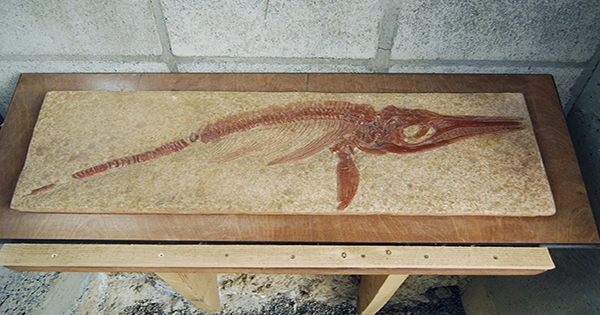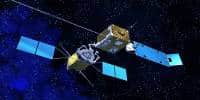For paleontologists, BERLIN, NEVADA, is a gold mine. A rockbound collection of bones just down the road from now-defunct gold and silver mines offers a glimpse at an even richer past. Numerous fossilized remains of extinct sea reptiles can be found throughout the Berlin-Ichthyosaur State Park. That bone bed is so plentiful and peculiar that scientists have been puzzling over it for decades.
“There are sites with considerably more dense occurrences of ichthyosaur skeletons,” claims Nick Pyenson, curator of fossil marine animals at the Smithsonian National Museum of Natural History. “Places in Chile and Germany are two such locations. However, for a very long time, Berlin-Ichthyosaur in eastern Nevada has eluded understanding. At least seven members of the species Shonisaurus, a bloated, bus-sized dolphin with four limb-like flippers, lay practically stacked on one another in one quarry.
Previous theories mainly concentrated on the physical or environmental causes of the fossil cluster. One theory put up claimed that the animals perished as a group about 230 million years ago after being stuck in shallow water. Or perhaps a volcanic eruption destroyed them. In addition to employing 3D models of the location and other geological hints, Pyenson had another theory that his team explored.
Today Pyenson’s team publishes evidence that the shonisaurs traveled there to reproduce in the journal Current Biology. The team comes to the conclusion that the creatures, like certain whales today, traveled great distances to give birth. The discovery is not only the first known instance of group migration to a specified calving place but also an illustration of “convergent evolution,” in which the same qualities independently emerge in various species.
Lene Liebe Delsett, a vertebrate paleontologist at the University of Oslo in Norway who was not involved in the study, thinks that “they’re presenting quite a persuasive case.” “The first huge marine tetrapods were ichthyosaurs. There was a lot of diversity during the Triassic because of how much they varied from one another. Simply put, it’s a highly interesting era to learn more about.
A great deal of death opens THE ORIGIN STORY of the shonisaurs.
The greatest extinction event on Earth, which occurred between the Permian and Triassic periods 251 million years ago, wiped out almost 95% of all marine life. During this so-called “Great Dying,” the ocean’s diverse fauna was decimated.
Some of the creatures that sprung back into their place ended up being stranger and bigger than ever.
Following the Triassic, an evolutionary arms race began. Predators crushed through ammonite shells and pursued fish better than ever while prey evolved harder shells and improved mobility, and so on. This pressure was partially generated by ichthyosaurs, who soon took control of the water after evolving from terrestrial reptiles into new species of varying sizes. Particularly the Shonisaurus genus grew to be among of the largest marine predators ever. They first attained whale sizes, according to Pyenson.
Normally, Pyenson is more of a whale enthusiast; he is an expert in mammals, which diverged from reptiles around 325 million years ago. However, certain extinct marine reptiles, such as those in the order Ichthyosaur, resemble modern marine mammals in many ways. They are tetrapods, which means four-limbed, which means that their ancestors were terrestrial animals that gave birth to live young and shared similar flippers. And Pyenson is knowledgeable about this kind of enigma. He and his South American colleagues demonstrated about ten years ago in Atacama, Chile, using 3D mapping and chemical analysis that a dense cluster of at least 40 petrified whales must have perished from a poisonous algal bloom 7 to 9 million years ago.
Because 3D scanning made it possible for the data to be studied far from the real site over extended periods of time, Pyenson calls it “a tidy proof of concept” and “a unexpected result.” Because none of those fossil whales ever left Chile, it was novel.
He recalled discussing the convergent evolution of the features shared by ichthyosaurs and marine mammals with Vanderbilt University paleontologist and research coauthor Neil Kelley when it came to the riddle of Nevada’s boneyard. According to Pyenson, “We put our minds together.” What if there were convergences in behavior as well as anatomy?
To test these theories, they used extensive 3D scans of the location and chemical analysis. Long-range lasers enable scientists to centimeter-scale digitize vast landscapes (like fossil sites). The generated “point cloud” displays the spatial location of each skeleton. One photo doesn’t really provide the kind of data you need to evaluate your theories when dealing with skeleton pieces that are that huge and dispersed across such a large area, according to Pyenson. The enormous benefits of constructing an undistorted 3D model may be seen here.
First, they disproved one of the earlier explanations, mass stranding, using the site’s geological evidence. The surrounding mudstone and carbonate silt around the specimens show that the location was submerged deep. The scientists also disproved the idea of a deadly volcanic eruption because they could find no indication of it, such as elevated mercury levels in the rock.
They then made an effort to determine what else might have been going on. Although the sea was deep, they deduced from the position that the site had not been too far from shore. Even though Nevada is currently an interior state, it is believed that this park was once a tropical gulf close to an archipelago, or group of islands. Archipelagos are excellent locations if you want to feel safe, according to Pyenson. When you take into account the other hints we gathered, the location becomes quite crucial.
The team’s analysis of fossils revealed their demography to be the most important hint. Each was either extremely large or extremely diminutive—so small as to be an embryo or a newborn. According to Pyenson, “We believe that these are the bones of recently born or soon-to-be-born ichthyosaurs from this period.” The search turns up nothing else. Given the abundance of bones and the fact that there were no teenagers, they believe that these animals frequented this location for hundreds of thousands of years as a group nursery or calving area.
According to Pyenson, this shows that the animals’ feeding areas and maternity areas were separate from one another. He claims that they travel great distances in order to give birth and eat in different locations. The large oceangoing predators of today, such as giant whales and sharks, exhibit it. Also, absent from this location is any indication of enormous prey that might have sustained such large ichthyosaurs.
Pyenson is fascinated by the behavioral overlap among such diverse species. Sharks developed far earlier than ichthyosaurs. Whales developed decades later. But the same actions continue to occur. If you’re interested in learning more about his team’s findings, you may visit an interactive website.)
Despite being “the most essential thing that animals do,” Delsett claims that reproduction is understudied in the wild. Delsett applauds the new study’s thoroughness and is already considering ways to apply its findings to her own work. She has been researching an area in the Norwegian archipelago of Spitsbergen that is home to roughly 30 ichthyosaurs. We have one unanswered question, she says: “Why do we have so many ichthyosaurs in one site? “This structure is sound. I can make advantage of all of these research avenues.
The study’s non-participating paleontologist Mark McMenamin concurs that the laser scanning approach used by the researchers is beneficial to the field. He rejects their view, nevertheless. McMenamin has long maintained that a large, extinct cephalopod, such as an octopus or squid, killed the shonisaurus and purposefully arranged its bones at the odd Nevada site. McMenamin observes patterns in the skeletons: a partial tail without any other attachments may be the remains of a death; tessellations or tiling in the fossil bones may indicate intentional manipulation.
He explains, “They’re out hunting in blue water, and something else out there started pursuing them. (The Triassic Kraken hypothesis has not been supported by peer review.)
The kraken theory is categorically rejected by Pyenson. According to him, “I would charitably say it’s an unrealistic and untestable hypothesis.” It presupposes the presence of taxa and behaviors for which there is no supporting data. He claims that there are no signs of predation, such as teeth marks, on that lone tail bones. And the reason the bones fell in line like dominoes may be the only reason the tessellations McMenamin observed appear regular. We believe we have identified a strong biological basis for the conduct—grouping behavior, according to Pyenson.
The two concepts nevertheless show that certain information from 230 million years ago is just unknown. For instance, the current study leaves open the question of how these ichthyosaurs truly perished. Possibly never, says Pyenson. The bones aren’t as well preserved since the fossil site has been “massively damaged by tectonism and only that amount of geologic time,” he claims.
Fossils can sometimes be explained in unexpected ways by new information or techniques. In the past, paleontologists believed that shonisaurs were toothless filter-feeders, similar to modern-day great whales, consuming the little prey that was slid into their jaws. They then discovered grownups who had teeth. Even other ichthyosaurs may have been prey for Shonisaurus. “We have no idea. That is one of the numerous mysteries, according to Pyenson. “It’s incredibly difficult for us to restore that food network.”
He says, “We do our best, move the ball as far downfield as we can, and leave the rest for the next generation of scientists. Unsatisfactory answers are just part of the job.”
















